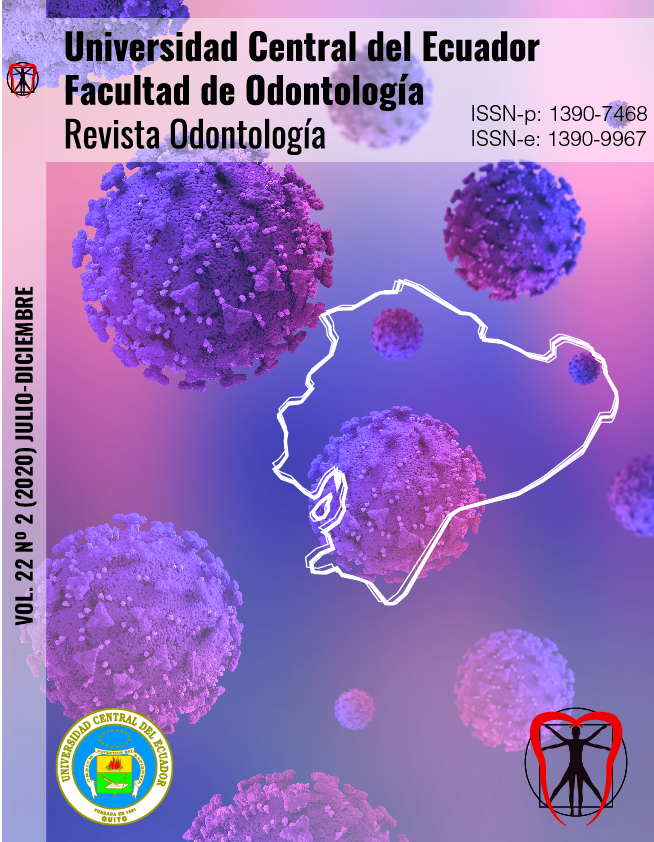Cyclical fatigue of four reciprocating systems in a dynamic dump of simulating roots
DOI:
https://doi.org/10.29166/odontologia.vol22.n2.2020-33-44Keywords:
Nanoparticles, antimicrobial disc diffusion tests, mutans streptococci, microbiology, orthodontics, in vitro techniquesAbstract
The fixed appliances used in orthodontics make proper oral hygiene difficult, in these conditions the development of carious lesions can be a complication, one of the main etiologic agents involved is Mutans streptococci. It was determined that silver nanotechnology has an important preventive application in dental biomaterials. Objective: Antimicrobial activity on Mutans streptococci of silver nanoparticles (AgNPs) included in orthodontic adhesives at different concentrations. Materials and methods: In 20 Petri dishes with Mutans streptococci inoculated in Müller-Hinton agar supplemented with 5% blood, 6 paper discs were placed, 4 soaked up with AgNPs included in an orthodontic adhesive at concentrations of 25, 75, 125 and 175 ppm, and 2 control discs with 0.12% chlorhexidine and distilled water. Antimicrobial capacity was determined based on averages of inhibition halos at 48 hours of incubation, compared to the Duraffourd scale and 0.12% chlorhexidine. Results: At 25 ppm there was no antibacterial capacity, at 75 ppm 50% reached limit sensitivity, but 100% of the samples at 125 and 175 ppm achieved limit sensitivity, however, chlorhexidine 0.12% showed higher sensitivity between average 60% and highly sensitive 40%. Conclusión: Silver nanoparticles smaller than 100 nm, included at 125 and 175 ppm in orthodontic adhessives, have antimicrobial activity on Strptococcus mutans, however, when studying, they don’t reach the sensitivity of chlorhexidine at 0.12%.
Downloads
References
Weine F. Tratamiento endodoncia. quinta edición ed. Madrid: Editorial Harcourt Brace; 1997.
Hulsmann M, Peters O, Dummer P. Mechanical preparation of root canals: shaping goals, techniques and means. Endodontic Topic. 2005; 10(1): p. 30-76.
Soares J, Goldberg F. Endodoncia técnica y fundamentos. primera edición ed. Argentina: Editorial Médica Panamericana; 2002.
Rodríguez YE. Aleación de Níquel-Titanio y su uso en Endodoncia. Acta Odont. Venez. 2000; 38(1): p. 1-4.
Soares J, Goldberg F. Endodoncia Técnica y Fundamentos Madrid: Editorial Médica Panamericana; 2002.
Fernández Y, Mendiola C. Evolución de los sistemas rotatorios en endodoncia: propiedades y diseño. Rev Estomatol Herediana. 2011; 21(1): p. 51-54.
Mohammad RN, Sedigh-Shams M, Abdolrasoulnia S. Cyclic Fatigue Life of Two Single File Engine-Driven Systems in Simulated Curved Canals. IEJ. 2018; 13(1): p. 61-65.
Gaitán C, Lara E, Flores H, Pozos A, Méndez V. Current Challanges and Concepts of the Thermomechanical Treatment of Nickel-Titanium Instruments. Odonvtos-Int. J. Dental. 2017; 19(1): p. 51-58.
Iacono F, Pirani C, Generali L, Bolelli G, Sassateli P, Lusvarghi L, et al. Structural analysis of HyFlex EDM instruments. International Endodontic Journal. 2016;: p. 1-11.
Thompson SA. An overview of nickel-titanium alloys used in dentistry. Int. Endod J. 2000; 33(4): p. 297-310.
Miyay K, Ebihara A, Hayashi Y, Doi H, Suda H, Yoneyama T. Influence of phase transformation on the torsional and bending properties of nickel-titanium rotatory endodontic instruments. J Endod. 2006; 39(2): p. 119-126.
De-Deus G, Nogueira E, Leal V, Goncalves F, Elias C, Plotino G, et al. Blue Thermomechanical Treatment Optimizes Fatigue Resistance and Flexibility of the Reciproc Files. JOE. 2016;: p. 1-5.
Pedullá E, Lo Savia F, Boninelli S, Plotino G, Grande N, La Rosa G, et al. Torsional and Cyclic Fatigue Resistance of a New Nickel-Titanium Instruments Manufactured by Electrical Discharge Machining. J. Endod. 2016; 42(1): p. 156-159.
Haapasalo M, Shen Y. Evolution of nickel-titanium instruments: from past to future. Endodontic Topic. 2013; 29(1): p. 3-17.
Kim HC, Kwak SW, Cheung GP, Ko DH, Chung SM, Lee W. Cyclic fatigue and torsional resistance of two new nickel-titanium instruments used in reciprocation motion: Reciproc versus WaveOne. J Endod. 2012; 38(4): p. 541-544.
Gutiérrez JF, Castañeda CM, León V, Ortiz M. Eficiencia del proceso de esterilización de las limas primarias WaveOne. Univ. Odontol. 2015; 34(73): p. 47-51.
Nogueira EJ, Hecksber F, Dos Santos H, De-Deus G, Elias CN, Leal VT. Torsional Fatigue Resistance of Blue-treated Reciprocating Instruments. J. Endod. 2018;: p. 1-4.
Aranguren J. WaveOne Gold. Surfea el conducto radicular con confianza. IEI.
Priori M, Hungaro MA, Monteiro C, Carvalho B, Tanomaru-Filho M, Guerreiro JM, et al. Cyclic fatigue and torsional strength of three different thermally treated reciprocating nickel-titanium instruments. Clinical Oral Investigation. 2018; 22: p. 1865-1871.
Keskin C, Inan U, Demiral M, Keles A. Cyclic Fatigue Resistance of Reciproc Blue, Reciproc, and WaveOne Gold Reciprocating Instruments. J. Endod. 2017; 43(8): p. 1360-1363.
Nieto SC, Mendoza PD. Estudio comparativo de los defectos superficiales de las limas Reciproc y WaveOne Gold después de la instrumentación de conductos radiculares en molares extraídos mediante el uso de Microscopía Electrónica de Barrido. Odonto Investigación. 2017;: p. 40-62.
Yared GM, Bou DFE, Machtou P. Cyclic fatigue of Profile rotatory instruments after simulated clinical use. J Endod. 2001; 32(1).
Guevara C. Repositorio Digital UCE. [Online].; 2017 [cited 2019 Enero 20. Available from: http://www.dspace.uce.edu.ec/handle/25000/10519.
Keskin C, Sariylimaz E, Demarai M. Shaping ability of Reciproc Blue reciprocating instruments with or without glide path in simulated S-haped root canals. J Dent Res Clin Dent Prospect. 2018; 12(1): p. 63-67.
Yared G. Reciproc Blue: the new generation of reciprocation. Giornale Italiano di Endodonzia. 2017; 31: p. 96-101.
G. Plotino, N.M. Grande, L. Testarelli, G. Gambarini. Cyclic fatigue of Reciproc and WaveOne reciprocating instruments. Int Endod J, 45 (2012), pp. 614-618
Published
How to Cite
Issue
Section
License
Copyright (c) 2020 Luis Martin Guevara Ruiz, Pablo Mauricio Bonilla Valladares, María Fernanda Caicedo Breedy

This work is licensed under a Creative Commons Attribution-NonCommercial-NoDerivatives 4.0 International License.


